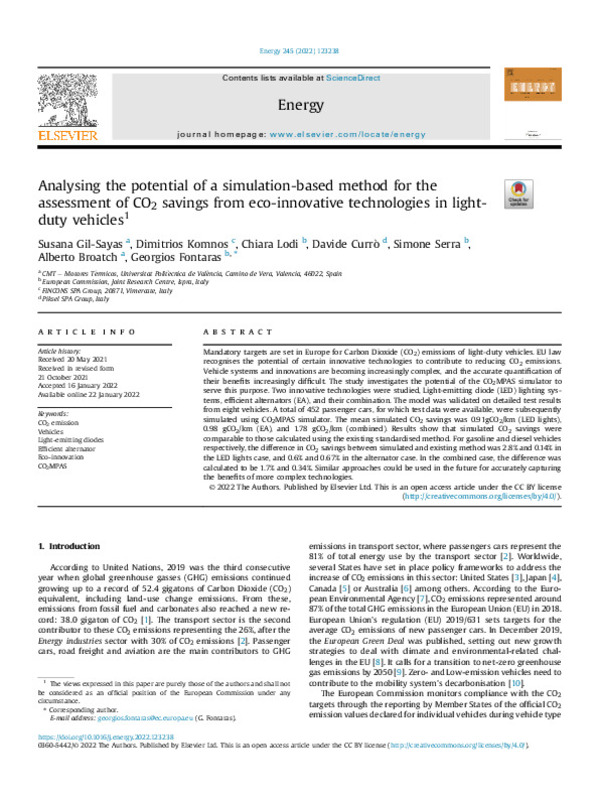JavaScript is disabled for your browser. Some features of this site may not work without it.
Buscar en RiuNet
Listar
Mi cuenta
Estadísticas
Ayuda RiuNet
Admin. UPV
Analysing the potential of a simulation-based method for the assessment of CO2 savings from eco-innovative technologies in light-duty vehicles
Mostrar el registro sencillo del ítem
Ficheros en el ítem
| dc.contributor.author | Gil-Sayas, Susana
|
es_ES |
| dc.contributor.author | Komnos, Dimitrios
|
es_ES |
| dc.contributor.author | Lodi, Chiara
|
es_ES |
| dc.contributor.author | Currò, Davide
|
es_ES |
| dc.contributor.author | Serra, Simone
|
es_ES |
| dc.contributor.author | Broatch, A.
|
es_ES |
| dc.contributor.author | Fontaras, Georgios
|
es_ES |
| dc.date.accessioned | 2023-05-29T18:02:50Z | |
| dc.date.available | 2023-05-29T18:02:50Z | |
| dc.date.issued | 2022-04-15 | es_ES |
| dc.identifier.issn | 0360-5442 | es_ES |
| dc.identifier.uri | http://hdl.handle.net/10251/193715 | |
| dc.description.abstract | [EN] Mandatory targets are set in Europe for Carbon Dioxide (CO2) emissions of light-duty vehicles. EU law recognises the potential of certain innovative technologies to contribute to reducing CO2 emissions. Vehicle systems and innovations are becoming increasingly complex, and the accurate quantification of their benefits increasingly difficult. The study investigates the potential of the CO2MPAS simulator to serve this purpose. Two innovative technologies were studied, Light-emitting diode (LED) lighting systems, efficient alternators (EA), and their combination. The model was validated on detailed test results from eight vehicles. A total of 452 passenger cars, for which test data were available, were subsequently simulated using CO2MPAS simulator. The mean simulated CO2 savings was 0.91gCO2/km (LED lights), 0.98 gCO2/km (EA), and 1.78 gCO2/km (combined). Results show that simulated CO2 savings were comparable to those calculated using the existing standardised method. For gasoline and diesel vehicles respectively, the difference in CO2 savings between simulated and existing method was 2.8% and 0.14% in the LED lights case, and 0.6% and 0.67% in the alternator case. In the combined case, the difference was calculated to be 1.7% and 0.34%. Similar approaches could be used in the future for accurately capturing the benefits of more complex technologies. | es_ES |
| dc.description.sponsorship | Authors would like to thank Mr Filip Francois, Ms Susanna Lindvall, and Mr Sotirios Kakarantzas of DG Climate Action for their valuable comments. A special thanks goes to Dr Vincenzo Arcidiacono who guided in the targeted sample CO2MPAS simulations which gave the starting point for this work, and to Dr Giuseppe Di Pierro who provided insight and expertise that greatly improved this work. | es_ES |
| dc.language | Inglés | es_ES |
| dc.publisher | Elsevier | es_ES |
| dc.relation.ispartof | Energy | es_ES |
| dc.rights | Reconocimiento (by) | es_ES |
| dc.subject | CO2 emission | es_ES |
| dc.subject | Vehicles | es_ES |
| dc.subject | Light-emitting diodes | es_ES |
| dc.subject | Efficient alternator | es_ES |
| dc.subject | Eco-innovation | es_ES |
| dc.subject | CO2MPAS | es_ES |
| dc.subject.classification | MAQUINAS Y MOTORES TERMICOS | es_ES |
| dc.title | Analysing the potential of a simulation-based method for the assessment of CO2 savings from eco-innovative technologies in light-duty vehicles | es_ES |
| dc.type | Artículo | es_ES |
| dc.identifier.doi | 10.1016/j.energy.2022.123238 | es_ES |
| dc.rights.accessRights | Abierto | es_ES |
| dc.contributor.affiliation | Universitat Politècnica de València. Escuela Técnica Superior de Ingeniería del Diseño - Escola Tècnica Superior d'Enginyeria del Disseny | es_ES |
| dc.description.bibliographicCitation | Gil-Sayas, S.; Komnos, D.; Lodi, C.; Currò, D.; Serra, S.; Broatch, A.; Fontaras, G. (2022). Analysing the potential of a simulation-based method for the assessment of CO2 savings from eco-innovative technologies in light-duty vehicles. Energy. 245:1-14. https://doi.org/10.1016/j.energy.2022.123238 | es_ES |
| dc.description.accrualMethod | S | es_ES |
| dc.relation.publisherversion | https://doi.org/10.1016/j.energy.2022.123238 | es_ES |
| dc.description.upvformatpinicio | 1 | es_ES |
| dc.description.upvformatpfin | 14 | es_ES |
| dc.type.version | info:eu-repo/semantics/publishedVersion | es_ES |
| dc.description.volume | 245 | es_ES |
| dc.relation.pasarela | S\482095 | es_ES |








